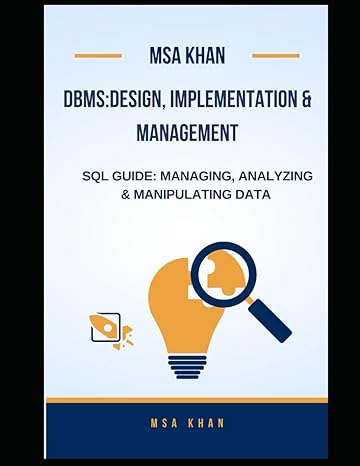Answered step by step
Verified Expert Solution
Question
1 Approved Answer
2. Problem Description-to-ER Diagrams To Relational Model: Design a database for each of the following problems. Draw a neat Entity-Relationship Diagram for each problem. Translate
2. Problem Description-to-ER Diagrams To Relational Model:
Design a database for each of the following problems. Draw a neat Entity-Relationship Diagram for each problem. Translate the diagram into a relational model. It is enough to show the table design like this:
TABLE_NAME(ColumnName1, ColumnName2, )
Underline the Primary Key.
Specify all the Foreign keys like this:
ColName FOREIGN KEY REFERENCES ANOTHER_TABLE(OtherColName).
c) Micro loans are small loans, which has gained popularity especially among borrowers in developing countries. The idea is to bring venture lenders together using information technology. Typically, the loans will be used to finance startup or development of the borrowers company, so that there is a realistic chance for repayment. The money in a loan can, unlike traditional loans, come from many lenders. (10 pts)
In this problem, you are asked to create an E-R model that describes the information necessary to manage micro loans. The following information form the basis for creating the model:
Each borrower and lender has an Id, name and address.
A loan starts with a loan request, which contains information about when the loan should at the latest be granted, the total amount requested, and how long the payback period is. Also, a description is included of how the money will be used. The rent on the payment is calculated in the loan amount, which is to say, the full amount is not paid.
Lenders can commit to an optional portion of the total amount of a loan request.
When the commitments for the loan request covers the requested amount, the request is converted to a loan. If not enough commitments can be reached, the loan request is cancelled. A borrower can have more than one request, and more than one loan at a time, but can at most make one request per day.
The loan is paid through an intermediary, typically a local department of a charity, who has a name and an address.
The borrower chooses when he or she will make a payment. Every payment must be registered in the database with an amount and a date (at most one payment per loan per day). The lenders share the repayment based on how large a part of the loan they are responsible for.
If the loan is not repaid before the agreed upon deadline, a new date is agreed. The database must not delete the old deadline, but save the history (the deadline can be overridden multiple times).
Each lender can for each burrower save a trust, which is a number between 0 and 100 that determines the lenders evaluation of the risk of lending money to that person. The number must only be saved for the borrowers, for whom there has been made such an evaluation.
Make an E-R model for the data described above. If you make any assumptions about data that doesnt show from the problem, they must be described. Put an emphasis on having the model express as many properties about the data as possible, for instance participation constraints.
Step by Step Solution
There are 3 Steps involved in it
Step: 1

Get Instant Access to Expert-Tailored Solutions
See step-by-step solutions with expert insights and AI powered tools for academic success
Step: 2

Step: 3

Ace Your Homework with AI
Get the answers you need in no time with our AI-driven, step-by-step assistance
Get Started


